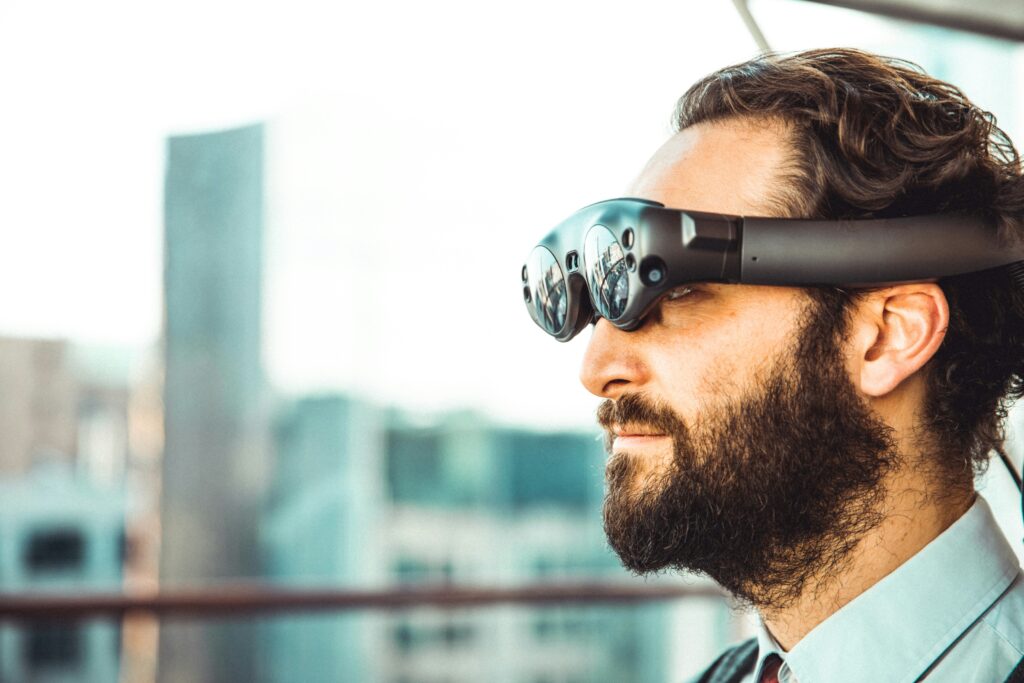The Possibilities of Extended Reality in Software Development

Extended Reality (XR), encompassing Augmented Reality (AR), Virtual Reality (VR), and Mixed Reality (MR), is rapidly redefining the software development landscape. Its potential to revolutionise the way we design, build, and interact with software is incredibly exciting, unlocking new possibilities in areas like prototyping, collaboration, and user experience.
Key XR Concepts and Technologies
At its core, XR seamlessly blends the digital and physical worlds, offering unique functionalities and user experiences. Here’s a closer look at each technology:
- Augmented Reality (AR) – AR consists of layers of digital information seamlessly overlaid onto the real-world environment. Developers can use AR to visualise 3D models in situ, enhance usability testing by placing prototypes within real-world contexts, and provide context-sensitive in-app assistance through AR overlays.
- Virtual Reality (VR) – VR is all about creating fully-realised digital worlds. Developers can leverage VR for rapid prototyping, allowing users to interact with prototypes in a simulated environment and providing invaluable feedback before actual development begins. VR excels at immersive testing, enabling thorough analysis of user behaviour and interaction within virtual prototypes.
- Mixed Reality (MR) – bridging the gap between AR and VR, MR blends digital elements with the physical world, creating a cohesive hybrid environment. Developers can use MR for collaborative design sessions, where teammates can co-create in shared virtual workspaces, manipulating digital objects within the context of the real world. Spatial interactions and shared visualisation foster efficient collaboration and enhance communication.
While hardware limitations and user interface design challenges remain, advancements in XR technology are accelerating. Lighter headsets, improved haptics, and refined software are bringing immersive experiences closer than ever.
Key Possibilities for XR in Software Development
XR has immense potential to revolutionise the way we design, build, and interact with software. Here are some key areas where XR promises to unlock groundbreaking possibilities:
- Enhanced Prototyping and Design – XR empowers developers to move beyond static mockups and create interactive prototypes that users can experience in real time. VR environments provide unparalleled spatial context, allowing users to intuitively interact with prototypes and provide valuable feedback. AR, on the other hand, facilitates overlaying design elements onto real-world settings, enabling developers to evaluate usability and user reactions within the intended context. This iterative process leads to faster development cycles and more refined final products.
- Revolutionising Collaboration and Communication – XR transcends geographical boundaries, offering virtual co-creation spaces where developers can collaborate seamlessly, regardless of location. Shared virtual environments provide immersive spaces for brainstorming sessions, whiteboard meetings, and problem-solving. Spatial visualisation and interaction foster more engaging communication and break down traditional collaboration barriers.
- Transforming User Experience – XR opens doors to intuitive and engaging user interfaces that seamlessly blend with the physical world or virtual environments. AR can provide context-sensitive in-app overlays and assistance, guiding users through tasks and enhancing their overall experience. VR enables the creation of immersive training simulations and product demonstrations, allowing users to interact with complex systems or experience products in a realistic setting before they even exist.
Challenges and Considerations for XR Development
While XR holds immense promise for software development, it’s important to acknowledge its hurdles and potential pitfalls. One challenge lies in accessibility. High-end VR headsets can be expensive, leaving smaller studios and individual developers behind. Innovative solutions like affordable mobile VR or cloud-based platforms are needed to democratise access. Additionally, the current hardware landscape prioritises high-end experiences, neglecting more portable or specialised tools for specific development needs. Lightweight AR glasses and haptic feedback gloves could unlock exciting new possibilities.
Designing user interfaces for XR environments also presents unique challenges. Traditional buttons and menus need to adapt to 3D spaces. Intuitive interaction methods like gaze control, gestures, and voice commands can bridge this gap. However, extended immersion can lead to fatigue and decreased cognitive performance. Developers must prioritise design principles that mitigate these effects, like incorporating breaks and balancing virtual and real-world interactions. Finally, user education and clear tutorials are crucial to overcome the initial learning curve and ensure user comfort.
Ethical considerations are paramount when navigating XR technology. The immersive nature of these experiences raises concerns about addiction and neglecting real-world responsibilities. Responsible XR should be encouraged through ethical design practices and user education. Additionally, XR collects vast amounts of user data, making data privacy and security crucial concerns. Developers must prioritise transparency, user control over their information, and robust security measures. Finally, the potential for misuse of XR technology for manipulation, misinformation, or discrimination can’t be ignored. Ethical guidelines and regulations are vital to ensure XR is used responsibly with good intentions.
The Future of XR in Software Development
While today’s XR technology offers many exciting possibilities, there is still much more to come. Enhanced sensory fidelity, courtesy of haptic feedback, temperature manipulation, and even olfaction technology will blur the lines between reality and simulation, enabling hyper-realistic design, testing, and user experiences. Personalisation will no longer be a buzzword but a reality. XR environments will learn and adapt to individual users’ preferences and needs. But the human touch won’t be replaced – it will be amplified. Brain-computer interfaces (BCI) promise direct control over virtual environments through our thoughts.
Of course, as we venture into this uncharted territory, ethical considerations and responsible development must come first. But with careful planning and collaboration, the future of XR in software development promises to be an immersive, empowering, and transformative journey.
Even in the short term, the potential of XR to transform software development is undeniable. Its capacity to unlock creative freedom, enhance collaboration, and deliver transformative user experiences should resonate with all developers. Resources and communities dedicated to XR in software development are readily available, empowering developers to join the forefront of this transformative movement. The call to action is clear: embrace XR and shape the future of software with the power of immersive experiences.